The Blueberry Extract Antioxidants Market is projected to grow from USD 1,252.7 million in 2025 to USD 4,023.8 million by 2035, representing an increase of USD 2,771.1 million, which equals a growth of 221% over the decade. The overall expansion represents a CAGR of 12.4%, signaling sustained demand for antioxidant-rich formulations.
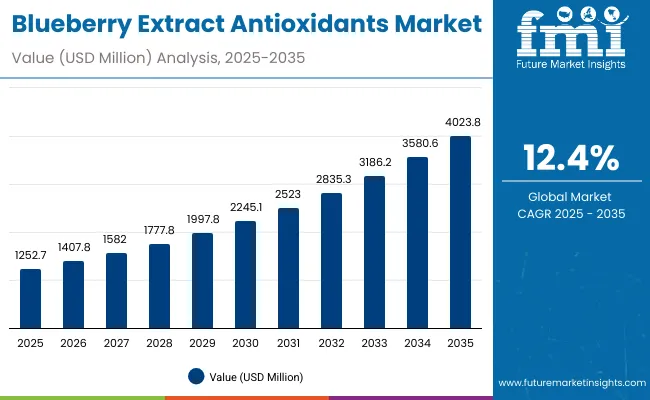
Blueberry Extract Antioxidants Market Key Takeaways
| Metric | Value |
|---|---|
| Blueberry Extract Antioxidants Market Estimated Value in (2025E) | USD 1,252.7 million |
| Blueberry Extract Antioxidants Market Forecast Value in (2035F) | USD 4,023.8 million |
| Forecast CAGR (2025 to 2035) | 12.4% |
During the first five-year period from 2025 to 2030, the market expands from USD 1,252.7 million to USD 2,245.1 million, adding USD 992.4 millionabout 36% of total decade growth. This growth phase is driven by rising adoption of blueberry extract in free radical protection and anti-aging formulations, especially across creams/lotions and serums.
The second half, from 2030 to 2035, contributes USD 1,778.7 million, or 64% of decade growth, as the market rises from USD 2,245.1 million to USD 4,023.8 million. Accelerated uptake of natural/organic certified serums and specialty pharmacy-based sales channels is expected to drive this surge, supported by strong consumer preference for dermatologist-tested and clean-label claims.
From 2020 to 2024, the Blueberry Extract Antioxidants Market laid the foundation for growth as consumer interest in plant-derived antioxidants accelerated. Skincare products emphasizing free radical protection, anti-aging, and natural/organic claims drove much of the momentum. The competitive landscape during this period was led by premium skincare brands and clean-label innovators, who together controlled the majority of revenue by leveraging ingredient transparency, dermatologist-tested positioning, and sustainability narratives. Service-based personalization models had minimal traction, contributing less than 10% of overall value.
Demand for Blueberry Extract Antioxidants is projected to reach USD 1,252.7 million in 2025, with the revenue mix shifting toward serums and creams/lotions, supported by natural/organic certifications and specialty retail expansion. Traditional leaders now face growing competition from indie and digital-first brands, which are offering vegan, clean-label, and eco-certified formulations tailored for millennial and Gen Z consumers. The competitive advantage is shifting away from brand heritage alone toward ecosystem strength, product innovation, digital engagement, and recurring subscription models.
Consumers are increasingly prioritizing skincare that combats oxidative stress, premature aging, and environmental damage. Blueberry extract, rich in polyphenols, anthocyanins, and vitamins, delivers strong free radical protection, making it highly attractive in anti-aging and brightening formulations. With the global surge in urban pollution and digital lifestyle stressors, demand for antioxidant-driven products is accelerating, positioning blueberry extract as a core natural ingredient in skincare innovation.
The clean beauty movement is transforming the skincare market, with consumers actively choosing natural, organic-certified, and dermatologist-tested products. Blueberry extract aligns perfectly with this trend, offering a scientifically backed, plant-based ingredient with proven skin-repair and brightening benefits. Growing retail shelf space for organic and vegan skincare, coupled with transparent labeling, is boosting blueberry extract adoption across premium, pharmacy-led, and mass-market beauty categories, fueling consistent long-term growth.
The market is segmented by function, product type, channel, claim, and region. Functional categories include anti-aging, free radical protection, brightening, and skin repair, reflecting the diverse roles blueberry antioxidants play in improving skin resilience, tone, and long-term health. Based on product type, the segmentation includes serums, creams/lotions, masks, and oils, highlighting the wide range of delivery formats. Serums lead in precision formulations, while creams and lotions dominate daily skincare applications, with masks and oils supporting intensive treatments.
Sales channels are classified into e-commerce, pharmacies, specialty beauty stores, and mass retail, ensuring consumer accessibility across both digital and offline platforms. The rise of online marketplaces has expanded blueberry extract adoption, while pharmacy-led retail reinforces trust in dermatologist-tested products. Claims-based segmentation covers natural/organic, vegan, clean-label, and dermatologist-tested, underscoring the growing importance of ethical, transparent, and science-backed formulations in consumer decision-making.
Regionally, the scope spans North America, Asia-Pacific, and Europe, with country-level highlights including the United States, China, India, Germany, the UK, and Japan. Each of these markets shows differentiated adoption trends based on regulatory clarity, consumer awareness, and retail innovation.
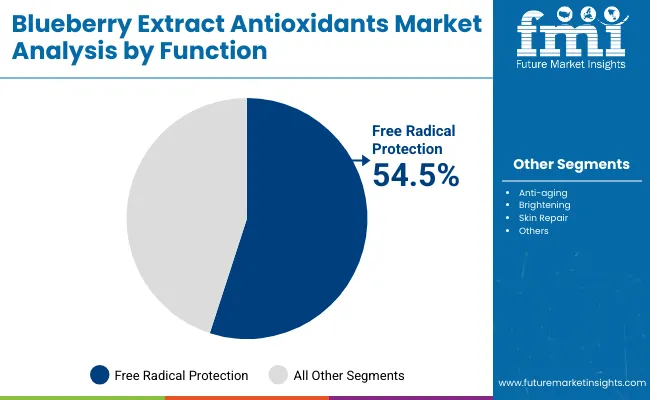
| Function | Value Share% 2025 |
|---|---|
| Free radical protection | 54.5% |
| Others | 45.5% |
The free radical protection segment is projected to contribute 54.5% of the Blueberry Extract Antioxidants Market revenue in 2025, making it the leading function category. This dominance is driven by growing consumer awareness of oxidative stress, pollution-related skin damage, and the need for antioxidant-rich formulations that prevent premature aging.
Growth in this segment is further supported by product innovation in creams, serums, and lotions, where blueberry extract’s high concentration of polyphenols and anthocyanins is leveraged to enhance skin defense. As consumer focus shifts toward preventive skincare, free radical protection is expected to remain the backbone of blueberry extract antioxidant applications over the forecast period.
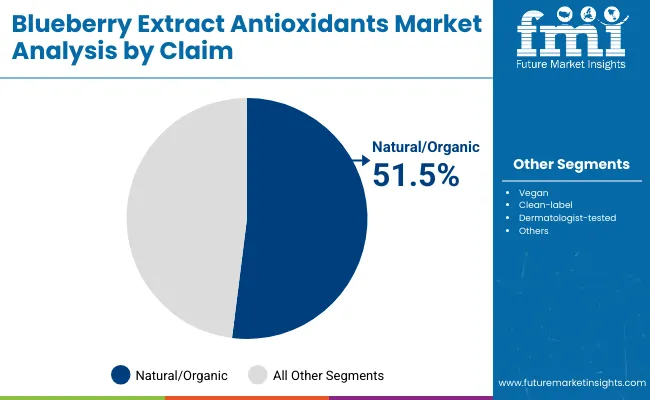
| Claim | Value Share% 2025 |
|---|---|
| Natural/organic | 51.5% |
| Others | 48.5% |
The natural/organic segment is forecasted to hold 51.5% of the market share in 2025, making it the leading claim category. This dominance is fueled by consumer demand for clean, plant-derived ingredients backed by clinical validation and transparency in sourcing. Blueberry extract, known for its antioxidant potency and skin-repair properties, is increasingly positioned as a hero ingredient in natural and organic skincare lines.
Its alignment with eco-conscious values, sustainability goals, and health-oriented consumer behavior has facilitated widespread adoption across both premium and mass-affordable beauty. Growth in this segment is further supported by the expansion of certified organic labels and retailer mandates for “green beauty” categories. As consumer trust in natural-origin and eco-certified products strengthens, the natural/organic segment is expected to maintain its leading position within the blueberry extract antioxidants market.
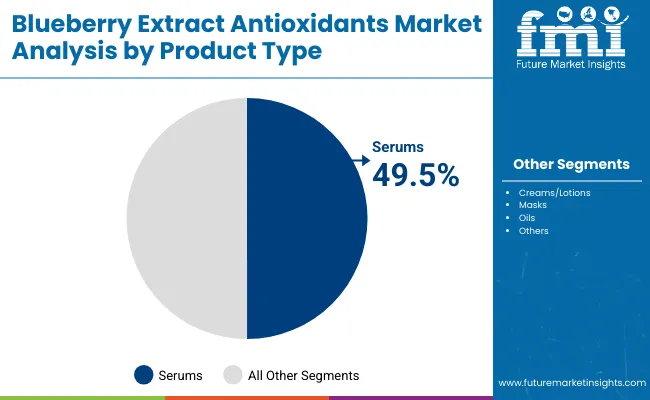
| Product Type | Value Share% 2025 |
|---|---|
| Serums | 49.5% |
| Others | 50.5% |
The serums segment is projected to account for 49.5% of the Blueberry Extract Antioxidants Market revenue in 2025, making it a leading product type. Serums are preferred for their high concentration of active ingredients and ability to deliver targeted results such as free radical protection, brightening, and anti-aging benefits.
Their lightweight texture and rapid absorption enhance consumer appeal, particularly among younger demographics seeking quick, visible outcomes. Growth is also fueled by the rise of premium skincare and clean-label serums offered through specialty beauty stores and e-commerce platforms. With ongoing innovation in antioxidant encapsulation and delivery systems, serums are expected to remain at the forefront of blueberry extract-based skincare adoption.
Rising Demand for Antioxidant-Rich Skincare
Consumers are increasingly aware of the damaging effects of pollution, UV radiation, and digital blue light on skin health. This has accelerated demand for antioxidant-rich products that provide free radical protection. Blueberry extract, loaded with anthocyanins, vitamin C, and polyphenols, is a natural fit for anti-aging, brightening, and barrier-repair solutions. The ingredient’s clinical credibility and natural origin make it highly attractive to consumers who are moving away from synthetic chemicals, strengthening its role in premium and mass skincare lines.
Growth of Clean Beauty and Organic Certifications
The clean beauty movement is fueling the adoption of natural, organic, and vegan-certified skincare. Blueberry extract aligns seamlessly with this trend, offering plant-based benefits supported by science. Retailers and beauty platforms are increasingly demanding eco-labeled and dermatologist-tested claims, creating more shelf space for antioxidant products. Younger demographics, especially Gen Z and Millennials, are gravitating toward transparent ingredient lists and sustainability commitments, pushing brands to invest in blueberry extract formulations as part of broader organic-certified and clean-label product portfolios.
Regulatory Complexity in Natural Ingredient Marketing
Despite the strong appeal of blueberry extract, inconsistent global regulations on labeling, organic certification, and ingredient claims remain a restraint. Varying standards between regions like the USA, EU, and Asia often delay product launches and create hurdles for smaller brands lacking regulatory expertise. Additionally, the risk of exaggerated claims in antioxidant efficacy may lead to consumer skepticism. This regulatory uncertainty not only increases compliance costs but also limits cross-border scalability, restricting some companies from fully capitalizing on blueberry extract’s rising popularity.
Integration of Blueberry Extract in Multi-Functional Skincare
A growing trend in the market is the integration of blueberry extract into multi-functional skincare formats. Consumers are seeking products that combine hydration, anti-aging, brightening, and barrier protection in one solution to simplify routines. Blueberry extract’s versatility allows it to be positioned across serums, creams, and masks with layered benefits. This trend is also supported by innovations in formulation science, such as encapsulation for sustained antioxidant release, and aligns with the broader “skinimalism” movement favoring fewer, more efficient skincare steps.
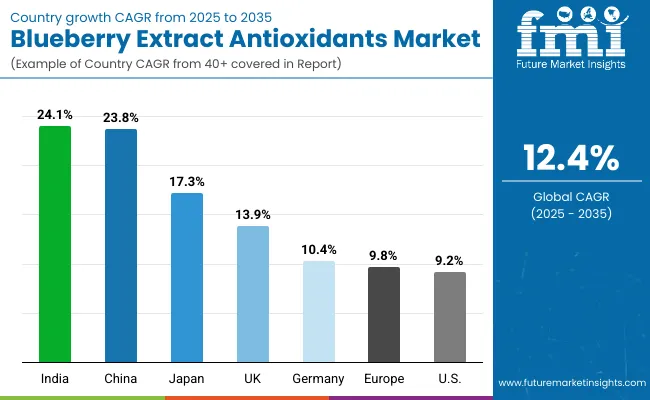
| Countries | Estimated CAGR (2025 to 2035) |
|---|---|
| China | 23.8% |
| USA | 9.2% |
| India | 24.1% |
| UK | 13.9% |
| Germany | 10.4% |
| Japan | 17.3% |
The global Blueberry Extract Antioxidants Market shows pronounced regional variation in adoption speed, largely influenced by consumer awareness, regulatory clarity, and retail channel innovation. Asia-Pacific emerges as the fastest-growing region, anchored by India (24.1% CAGR) and China (23.8% CAGR). Growth here is driven by expanding urban middle-class consumers, rising e-commerce penetration, and strong preference for natural and organic beauty. China benefits from the C-beauty ecosystem and social commerce platforms, while India’s growth reflects increasing demand for Ayurveda-aligned, plant-based skincare. Japan (17.3% CAGR) demonstrates strong adoption of blueberry extract in clinical-grade anti-aging and brightening products, reflecting its established dermo cosmetic culture. In Europe, the UK (13.9% CAGR) leads with consumer preference for vegan and sustainable beauty, while Germany (10.4% CAGR) continues to grow steadily due to its pharmacy-driven distribution and strict organic certification standards.
The USA (9.2% CAGR) shows more moderate growth, reflecting a mature beauty market where blueberry extract products are gaining share mainly through premium skincare brands, clean-label marketing, and AI-personalized regimens. While growth in North America is slower compared to Asia, innovation in D2C subscription models and digital-first beauty platforms continues to support steady expansion.
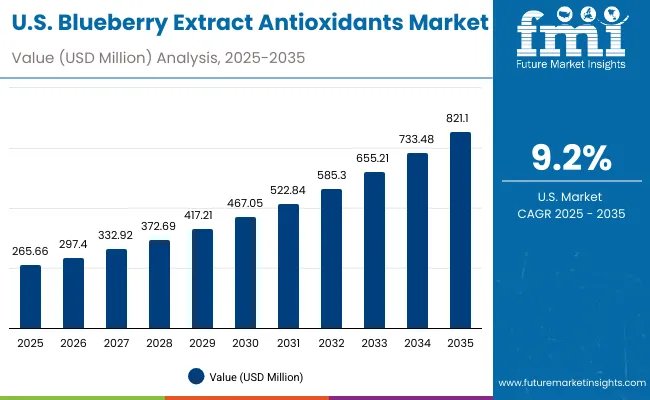
| Year | USA Blueberry Extract Antioxidants Market (USD Million) |
|---|---|
| 2025 | 265.66 |
| 2026 | 297.40 |
| 2027 | 332.92 |
| 2028 | 372.69 |
| 2029 | 417.21 |
| 2030 | 467.05 |
| 2031 | 522.84 |
| 2032 | 585.30 |
| 2033 | 655.21 |
| 2034 | 733.48 |
| 2035 | 821.10 |
The Blueberry Extract Antioxidants Market in the United States is projected to grow from USD 265.66 million in 2025 to USD 821.10 million by 2035, reflecting consistent expansion at a CAGR of 12.2%. Growth is primarily led by rising demand for free radical protection formulations, which account for nearly 59% of the USA market.
Consumer interest in anti-aging serums, creams, and lotions enriched with blueberry extract is driving uptake, supported by the clean-label and dermatologist-tested product wave. The expansion of e-commerce platforms, subscription-based D2C models, and pharmacy-led premium skincare categories further strengthens adoption. Increasing alignment with vegan and natural claims is also reshaping product portfolios across both mass and premium brands.
The Blueberry Extract Antioxidants Market in the United Kingdom is expected to grow at a CAGR of 13.9% from 2025 to 2035, supported by strong consumer demand for natural, vegan, and clean-label skincare solutions. British consumers are increasingly drawn to antioxidant-rich products for anti-aging, free radical protection, and brightening functions. Growth is further accelerated by indie beauty brands and clean-beauty retailers introducing blueberry extract serums and creams that combine transparency, sustainability, and dermatological efficacy.
Government-backed sustainability initiatives, along with consumer awareness of eco-friendly packaging, are also shaping the market. Online beauty platforms and specialty pharmacies are expanding their range of organic-certified antioxidant formulations, while premium retailers continue to highlight plant-based actives as part of the broader shift toward conscious consumption.
India is witnessing exceptionally rapid growth in the Blueberry Extract Antioxidants Market, forecast to expand at a CAGR of 24.1% through 2035the highest among key countries. This momentum is driven by the rising popularity of plant-based, antioxidant-rich skincare that resonates with India’s tradition of Ayurveda-inspired natural remedies. Blueberry extract is increasingly being adopted in anti-aging and free radical protection formulations, as consumers shift from synthetic to clean-label solutions.
Growth is also supported by the proliferation of D2C beauty startups in tier-2 and tier-3 cities, offering affordable blueberry-infused serums and creams online. Increased consumer awareness, amplified by influencer-led marketing and e-commerce platforms, is accelerating product penetration. Additionally, urban millennials and Gen Z are fueling demand for multi-functional antioxidant products that address pollution-related skin concerns, further strengthening India’s market expansion.
The Blueberry Extract Antioxidants Market in China is expected to grow at a CAGR of 23.8%, one of the highest among leading economies. Market expansion is driven by the surge of C-beauty brands, influencer-led marketing, and consumer preference for natural and organic-certified products. In 2025, natural/organic claims account for 54.5% of sales, underscoring the growing importance of transparency and eco-conscious formulations in consumer choices.
Rapid growth in serums and creams infused with blueberry extract is supported by strong adoption across Tier 1 and Tier 2 cities, where younger consumers demand multifunctional skincare that combines anti-aging, brightening, and free radical protection. Social commerce platforms such as Douyin and Little Red Book are playing a central role in accelerating awareness and trial adoption.
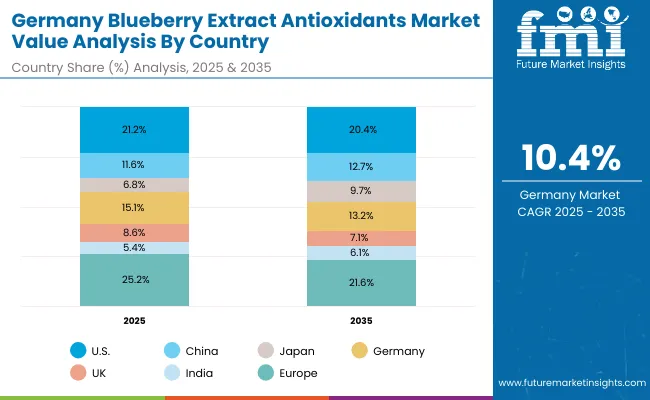
| Countries | 2025 Share (%) |
|---|---|
| USA | 21.2% |
| China | 11.6% |
| Japan | 6.8% |
| Germany | 15.1% |
| UK | 8.6% |
| India | 5.4% |
| Countries | 2035 Share (%) |
|---|---|
| USA | 20.4% |
| China | 12.7% |
| Japan | 9.7% |
| Germany | 13.2% |
| UK | 7.1% |
| India | 6.1% |
The Blueberry Extract Antioxidants Market in Germany is projected to grow at a CAGR of 10.4%, driven by the country’s established reputation for dermatologically tested and pharmacy-led skincare. Germany’s consumers strongly value organic-certified and natural-origin formulations, making blueberry extract an attractive ingredient in anti-aging, free radical protection, and skin-repair products. However, Germany’s global share is expected to decline modestly from 15.1% in 2025 to 13.2% in 2035, reflecting faster growth in Asia-Pacific markets.
Growth is supported by the expansion of pharmacy distribution channels, where consumer trust in clinically validated skincare drives adoption of antioxidant-rich serums and creams. Additionally, Germany’s strict EU-driven organic labeling and safety compliance standards reinforce blueberry extract’s positioning as a safe, sustainable active. Clean beauty retailers and premium brands are further boosting demand by integrating blueberry extract into multi-functional, eco-conscious formulations.
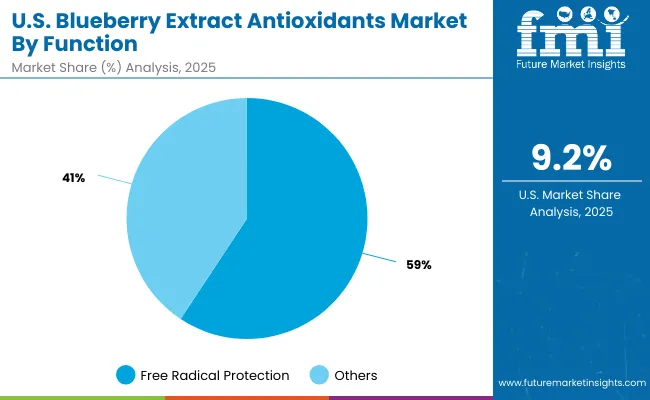
| USA by function | Value Share% 2025 |
|---|---|
| Free radical protection | 59.3% |
| Others | 40.7% |
he Blueberry Extract Antioxidants Market in the USA is projected at USD 265.66 million in 2025, with free radical protection emerging as the leading functional segment at 59.3% share. This dominance reflects heightened consumer demand for antioxidant-rich formulations that counteract oxidative stress, pollution, and UV-induced skin aging.
American consumers are particularly drawn to serums and creams enriched with blueberry extract for their quick absorption and clinically backed benefits. Growth is also supported by the rise of clean-label and dermatologist-tested claims, which reinforce consumer trust. As demand for multi-functional products grows, blueberry extract formulations combining hydration, brightening, and anti-aging are expected to sustain market expansion through both pharmacy channels and e-commerce-led D2C platforms.
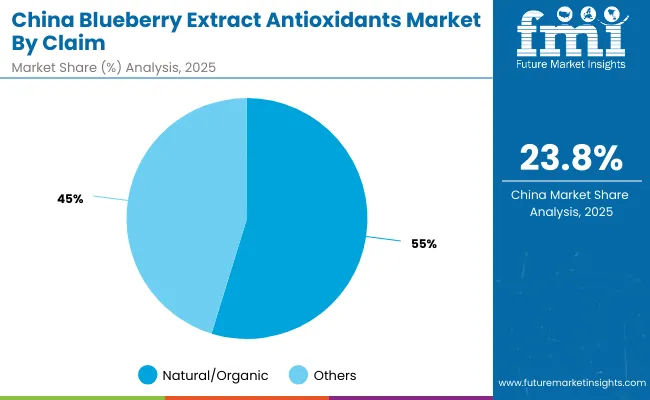
| China by Claim | Value Share% 2025 |
|---|---|
| Natural/organic | 54.5% |
| Others | 45.5% |
The Blueberry Extract Antioxidants Market in China presents significant opportunities, with natural/organic claims leading at 54.5% in 2025. This dominance reflects Chinese consumers’ rising trust in eco-certified, plant-based skincare solutions as part of their shift toward wellness-oriented lifestyles. Blueberry extract is increasingly positioned as a key antioxidant active in anti-aging, brightening, and free radical protection products that align with the C-beauty movement.
Opportunities are further amplified by the rapid growth of social commerce platforms such as Douy in and Little Red Book, which accelerate awareness and trial adoption of blueberry-based serums and creams. Domestic brands are leveraging competitive pricing and clean-label certifications to penetrate both Tier 1 and Tier 2 cities, while premium players highlight dermatologist-tested claims to build trust among affluent consumers.
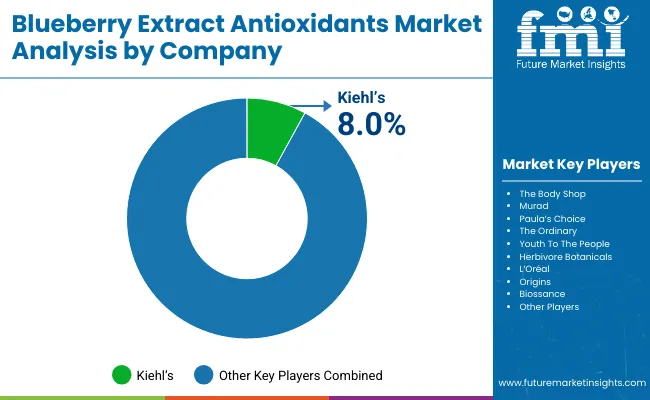
| Company | Global Value Share 2025 |
|---|---|
| Kiehl’s | 8.0% |
| Others | 92.0% |
The Blueberry Extract Antioxidants Market is moderately fragmented, with a mix of global leaders, mid-sized innovators, and niche-focused clean beauty brands competing across diverse skincare applications. Global leaders such as Kiehl’s, L’Oréal, and The Body Shop leverage brand heritage, extensive retail distribution, and strong R&D pipelines to secure competitive advantages. Their strategies emphasize blueberry-enriched serums and creams, paired with dermatologist-tested claims and premium positioning.
Mid-sized innovators including Paula’s Choice, Murad, and The Ordinary are driving growth by combining scientifically validated antioxidant claims with clean-label and vegan certifications. Their hybrid retail-digital presence, supported by strong consumer communities, accelerates adoption in both North America and Europe. Specialist brands such as Herbivore Botanicals, Youth To The People, and Biossance focus on eco-conscious formulations, sustainable packaging, and transparent ingredient sourcing. Their strength lies in targeting Gen Z and millennial consumers who prioritize ethical consumption and personalized routines.
Competitive differentiation is shifting from brand legacy alone toward ecosystem strength, where clean-label certifications, digital-first engagement, and subscription-based D2C models are emerging as key drivers of long-term loyalty in the blueberry extract antioxidants market.
Key Developments in Blueberry Extract Antioxidants Market
| Item | Value |
|---|---|
| Quantitative Units | USD 1,252.7 Million |
| Function | Anti-aging, Free radical protection, Brightening, Skin repair |
| Product Type | Serums, Creams/lotions, Masks, Oils |
| Channel | E-commerce, Pharmacies, Specialty beauty stores, Mass retail |
| Claim | Natural/organic, Vegan, Clean-label, Dermatologist-tested |
| Regions Covered | North America, Europe, Asia-Pacific, Latin America, Middle East & Africa |
| Country Covered | United States, Canada, Germany, France, United Kingdom, China, Japan, India, Brazil, South Africa |
| Key Companies Profiled | Kiehl’s , The Body Shop, Murad, Paula’s Choice, The Ordinary, Youth To The People, Herbivore Botanicals, L’Oréal, Origins, Biossance |
| Additional Attributes | Dollar sales by function and product type, including anti-aging, free radical protection, brightening, and skin repair across serums, creams/lotions, masks, and oils; adoption trends in natural/organic, vegan, clean-label, and dermatologist-tested claims; rising demand for multi-functional serums and creams designed for both daily care and targeted treatments; sector-specific growth in pharmacy-driven skincare, specialty beauty stores, and mass retail channels; revenue segmentation by e-commerce and offline distribution; integration with AI-powered skin diagnostics, AR/VR try-on tools, and personalized skincare platforms; regional trends influenced by consumer awareness, regulatory frameworks, and retail innovation; and innovations in antioxidant delivery, including encapsulation, bio-fermentation, and sustainable packaging technologies. |
The global Blueberry Extract Antioxidants Market is estimated to be valued at USD 1,252.7 million in 2025.
The market size for the Blueberry Extract Antioxidants Market is projected to reach USD 4,023.8 million by 2035.
The Blueberry Extract Antioxidants Market is expected to grow at a 12.4% CAGR between 2025 and 2035.
The key product types in the Blueberry Extract Antioxidants Market are serums, creams/lotions, masks, and oils. These formats highlight the versatility of blueberry extract, with serums leading in targeted applications and creams/lotions dominating daily skincare routines.
In terms of product type, the serums segment is projected to command the most significant share at 49.5% in 2025, reflecting growing consumer demand for high-concentration, antioxidant-rich skincare solutions.






Full Research Suite comprises of:
Market outlook & trends analysis
Interviews & case studies
Strategic recommendations
Vendor profiles & capabilities analysis
5-year forecasts
8 regions and 60+ country-level data splits
Market segment data splits
12 months of continuous data updates
DELIVERED AS:
PDF EXCEL ONLINE
Market Share Insights for Blueberry Ingredient Providers
Extraction Kits Market Analysis - Size, Share, and Forecast Outlook 2025 to 2035
Extracts and Distillates Market
Sage Extract Market Size and Share Forecast Outlook 2025 to 2035
Fume Extractor Market Size and Share Forecast Outlook 2025 to 2035
Meat Extracts Market Size and Share Forecast Outlook 2025 to 2035
Kale Extract Skincare Market Size and Share Forecast Outlook 2025 to 2035
Wine Extract Market Size and Share Forecast Outlook 2025 to 2035
Amla Extract Market Analysis - Size, Share, and Forecast Outlook 2025 to 2035
Dust Extractor Market Growth – Trends & Forecast 2025 to 2035
Data Extraction Software Market
Peony Extract Brightening Creams Market Analysis - Size, Share, and Forecast Outlook 2025 to 2035
Peony Extracts for Brightening Market Size and Share Forecast Outlook 2025 to 2035
Algae Extracts Market Size and Share Forecast Outlook 2025 to 2035
Juice Extraction Equipment Market Size and Share Forecast Outlook 2025 to 2035
Yucca Extract Market Size and Share Forecast Outlook 2025 to 2035
Maple Extracts Market Size and Share Forecast Outlook 2025 to 2035
Yeast Extract Market Analysis - Size, Share, and Forecast Outlook 2025 to 2035
Yeast Extract Industry Analysis in USA Size, Growth, and Forecast for 2025 to 2035
Basil Extract Market Size, Growth, and Forecast for 2025 to 2035

Thank you!
You will receive an email from our Business Development Manager. Please be sure to check your SPAM/JUNK folder too.
Chat With
MaRIA